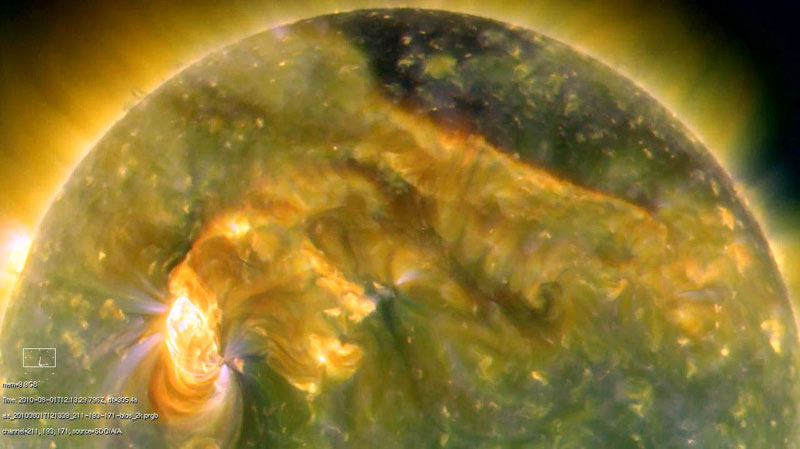Amazingly Fast Eruption on the Sun Photographed

One of the fastest big solar eruptions in years has beenobserved streaking away from the sun at more than 2.2 million mph by two NASAspacecraft.
The flare occurred Aug. 1 and created a massive suneruption called a coronal mass ejection that struck Earth's magnetic fieldTuesday, creating dazzlingaurora displays.? NASA's twin STEREO spacecraft recorded the eruption and beamedimages of the sun storm back to Earth. [Photo of the sun eruption.]
The materialejected from the sun was seen speeding toward Earth at more than 1,000kilometers per second, or just over 2.2 million mph (3.6 million kph). Anotherwave from the event was expected to hit Earth's magnetic field on Wednesday.NASA's two STEREO spacecraft, which monitor the sun's weather in 3-D, alsorecorded a videoof the sun eruption.
"These kinds of eruptions are one of the first signsthat the sun is waking up and heading toward another solar maximum expected inthe 2013 time frame," NASA officials said in a statement. The sun goesthrough a regular 11-year activity cycle. The last solar maximum occurred in2001 and its recent extreme solar minimum was particularly weak andlong-lasting, the space agency added.
Coronal mass ejections are eruptions of charged particlesfrom the sun that stream out over several hours. They can contain severalbillion tons of plasma and expand away from the sun at speeds of up to 1million mph (1.6 million kph). At such speeds, they can cross the 93million-mile (150 million-km) gulf between the Earth and sun in two to fourdays.
The material belched from the sun during the Aug. 1 flareis not expected to cause any disturbances on Earth other than creatingspectacular auroras. Auroras are created when charged particles are caught byEarth's magnetic field and interact with the atmosphere above the poles.
The Aug. 1 solar flare was a moderate C-class flare. Thecoronal mass ejection it set off created a strong so-called geomagnetic stormthat lasted nearly 12 hours ? enough time for auroras to spread from Europe toNorth America, NASA officials said in a statement.
Get the Space.com Newsletter
Breaking space news, the latest updates on rocket launches, skywatching events and more!
Stronger solar storms could cause adverse impacts tospace-based assets and technological infrastructure on Earth.
- Video of the Sun Eruption
- Gallery? Amazing Auroras of 2010, Sun Storms
- SpectacularNorthern Lights Show Signals Sun Is Waking Up
Join our Space Forums to keep talking space on the latest missions, night sky and more! And if you have a news tip, correction or comment, let us know at: community@space.com.

Space.com is the premier source of space exploration, innovation and astronomy news, chronicling (and celebrating) humanity's ongoing expansion across the final frontier. Originally founded in 1999, Space.com is, and always has been, the passion of writers and editors who are space fans and also trained journalists. Our current news team consists of Editor-in-Chief Tariq Malik; Editor Hanneke Weitering, Senior Space Writer Mike Wall; Senior Writer Meghan Bartels; Senior Writer Chelsea Gohd, Senior Writer Tereza Pultarova and Staff Writer Alexander Cox, focusing on e-commerce. Senior Producer Steve Spaleta oversees our space videos, with Diana Whitcroft as our Social Media Editor.









